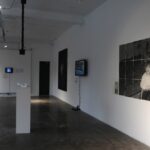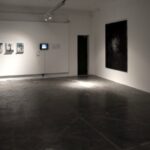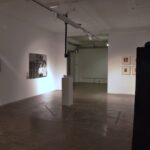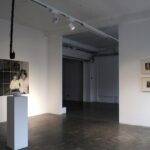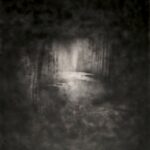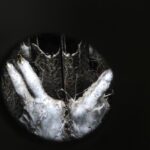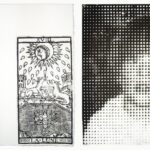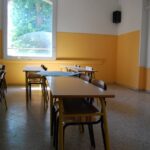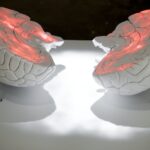Patria Interiore – Inner Homeland
Golden Thread Gallery, Belfast. 1-24 March 2012
For an exhibition in the Project space of the Golden Thread Gallery, a group of eight young Italian artists have confronted the issue of “Inner homeland” – a quote from volume 5 of Proust’s À la recherche du temps perdu, The Prisoner.
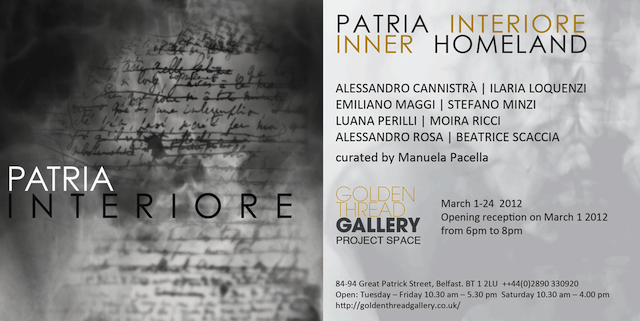
Amongst the many themes of À la recherche du temps perdu, nostalgia and involuntary memory are explored, and these themes have also been prevalent in the works of many Italian artists. Since 2001, Italy has seen many works that have investigated notions of shared memory and a common past, such as the documentary Un’ora sola ti vorrei by Alina Marazzi.
The artists that have been invited to participate in this exhibition can be divided into three groups. Firstly, those who are working in an explicit manner on the subject of memory, both private and collective, such as Stefano Minzi, Luana Perilli, Moira Ricci and Beatrice Scaccia. Secondly, those who approach memory obliquely, such as Ilaria Loquenzi with her participatory works and Alessandro Rosa’s universal linguistic codes, and thirdly, Alessandro Cannistrà and Emiliano Maggi whose works reference ancestral and archetypical memories.
The exhibited works are across a range of media including: photography; video; painting; engraving; and installation and includes original works specifically designed for this exhibition by Cannistrà, Loquenzi, Maggi, Rosa and Scaccia.
The exhibition was followed by a second chapter in which the 8 Italian artists and two Northern Irish guests – Brian Kennedy and Peter Richards – produced a specific work in response to the paragraph Les Intermittences du coeur contained in the volume Sodome et Gomorrhe of Proust’s Recherche du temps perdu.
These special projects were initially only conceived for the publication related to the Inner Homeland exhibition, published by NERO but then became the artworks for another exhibition in Rome, at Ex Elettrofonica, titled Les Intermittences du coeur where the book was first launched.
Inner Homeland
When the view of the universe changes, is purified, it becomes more appropriate to the memory of inner homeland; it is natural that this will result in a general alteration of the sound of the musician, as of the pain of the painter. (…) It is sensed, then, that it was a transposition of depth onto the field of sound.
Marcel Proust, The Prisoner, Book 5, À la recherche du temps perdu
(…) but also nostalgia for all that has been and will not return, for that from which we come and to which we feel more or less consciously related.
The nostalgic feeling as needed to overcome a loss.
Nostalgia as an essential condition of life.
Alina Marazzi, Un’ora sola ti vorrei (For One More Hour with You), 2002
At an inattentive, superficial reading, keeping only to the visible data and to preconceptions of themes like memory and nostalgia, the exhibition Inner Homeland, held in Belfast’s Golden Thread Gallery, might seem a collective show like any other, simply putting together eight artistic personalities who work with the past or memory.
The location itself instead shows the exhibition’s peculiarity. Belfast, with its tragic past, straight away transmits a strong emotional charge to the visitor. Beyond an immense ill-concealed suffering, and more than visible traces of a recent history still far from closure, the city is drunk with creativity and ready to bite into the future. Its port is loaded with a past as nostalgic as it is tragic, site of the Titanic’s construction; the peace lines are still there; the mountain with its profile the shape of Napoleon’s nose watches over the city perrenially; the countryside, the docks, the swans are subject to the moody climate that goes from rain to sun in the space of a few hours. Nothing seems connected and everything’s characterized by a sort of interprenetation of opposites. In such a setting the contemporary art to be seen there is charged with the urge to get to it.
The Proustian theme is as relevant as ever in this climate. Together with Proust, the director Alina Marazzi and her masterpiece Un’ora sola ti vorrei (For One More Hour with You) are the guidelines for eight artworks which – despite the profound differences between them – are gathered together to speak, at times to shout, of the necessity for a more attentive gaze, one that might grant us the possibility to read through, and so be able to feel, as Giuseppe Di Giacomo explains well in his notes on Proust [the author refers to the text written by Di Giacomo for the Patria Interiore publication].
In 1931 an essay on Proust came out signed by Samuel Beckett. Critics – and not only Beckett’s contemporaries – were disconcerted because they couldn’t see why Beckett had chosen Proust, sharing little in common with him as a writer. The reasons for the disregard for, or incapacity to understand that essay are well explained by Sergio Moravia: “One of the reasons for this unease is connected with the popular image of the author of Recherche. (…) Marcel Proust was a poor young man, very sick and sad (also because of an unconfessable vice), who, in order to respond to the anguishes of his present, wanted to re-evoke his past, consoling himself with childhood and adolescent memories of maternal kisses, of the sweet face of his grandmother, of his first erotic games, of soirées at the Guermantes’. As for the Recherche du temps perdu, it’s simply the lyrical-pathetical reconstruction of these memories.” And further on: “But the characterization is false. And what’s even more false is the image of Recherche and the overall ‘meaning’ that lies behind it. To realise this, it’s enough to read the book with the least lucidity, without stopping at the kiss and the madeleine, Francoise and tante Léonie: taking seriously, instead, the author’s programmatic declarations, and giving the right weight (a weight that’s moreover evident) to the dominant themes of the Recherche.”[1]
The ‘right weight’ should be given to the works chosen for this exhibition. Doing this means leaving your prejudices behind, opening to them, not stopping at mere form. Probably, as in Proust’s case, none of these artists aims at dissociating form from content. Proust’s style, with its broad use of metaphors, “fatigues, but doesn’t fatigue the brain. The clarity of the phrase is cumulative and explosive. One’s fatigue is a fatigue of the heart, a blood fatigue. (…) It is significant that the majority of his images are botanical. He is conscious of humanity as flora, never as fauna. (…) Flower and plant have no conscious will. They are shameless, exposing their genitals.” [2]
Presumably the works of the artists of Inner Homeland should be regarded as indecent, void of morality, if we follow the accusation often brought against certain self-referentialities for being too closely linked to biographical fact.
Such an accusation isn’t surprising, and not only because it’s evident that a part of the self is present in every artwork, but also because in an accusation like this a badly hidden judgment can be sensed, a sourness that shows a sore point has been touched.
The artists chosen for this exhibition – like, of course, many others – simply achieve the goal of stripping things of their usual and familiar vestments and so creating an immediate reaction, both positive and negative.
continue after images…
- Alessandro Cannistrà, “È (It Is)”, 2012, smoke on canvas, 200×150 cm.
- Ilaria Loquenzi, “Memorie silenziose: Pino Romano di Monte Mario; Mandorlo di Viale Mazzini; Platano di Piazza Barberini”, 2012, photographic cutting, pencil, charcoal and acrylic on paper, 40×30 cm each. [detail with the almond tree of Viale Mazzini]
- Emiliano Maggi, “Savage cry blood”, 2012, installation with wax sculpure, mirrors, strobe light and audio in a ca. 170x55x50 cm prismatic block. [detail]
- Stefano Minzi, “18 (la Lune)”, 2010, xerox transfer on paper, 118.5×161 cm (18 Hanemülle paper sheets, 39.5×26.5 cm each). [detail]
- Luana Perilli, “Ricreazione (Recess)”, 2011, stop motion video. Courtesy of The Gallery Apart, Rome (IT). [video still]
- Moira Ricci, “20.12.53-10.08.04. Gemellini (Baby Twins)”, lambda print on aluminium, 21×15 cm.
- Alessandro Rosa, “Inner Homeland”, 2012, video projection on anatomical model, variable size.
- Beatrice Scaccia, “At Least a Snake”, 2011-2012, loop animation and a short text. [video still]
These works should be read bearing in mind that habit is a “shell that conceals our deeper nature. Because our nature is first of all sense, body, desire, and habit is culture, artifice, repetition.”[3] And these artists have cancelled habit – an expert interior decorator (as Proust says) – giving the viewer the opportunity to probe their own depths. In Time Regained, the last and revelatory volume of the Recherche, Proust writes of his readers: “It would be my book, but with its help I would furnish them with the means of reading what lay inside themselves.”[4]
This, then, is how differently the artists in the exhibition approach the theme. There’s an initial directive, apparently straightforward, whereby the memory of the past is made evident through an immediate figuration, and this to be found in Stefano Minzi, Luana Perilli, Moira Ricci and Beatrice Scaccia. Instead, Ilaria Loquenzi and Alessandro Rosa confront memory in a subtler manner, verticalized by elements not directly referable to the theme. Finally, in Alessandro Cannistrà and Emiliano Maggi, a sensory and circular short-circuit occurs that brings the viewer into the work.
In the 2010 piece 18 (la lune), Stefano Minzi subjects a photo of his family, and so his own past, to a double process of breaking-down and analysis. In the first place, the original image has been much enlarged. Secondly, the chosen technique, of a transfer from a photocopy, makes the image’s reading even more difficult, having been soiled by the passage on paper from so perishable and unstable matrix as an ink-soaked sheet. The photo of the child Minzi together with his nanny has then been broken down into 18 equal parts to form a sort of polyptych of his childhood. Though the photo was initially chosen randomly, in executing the work Minzi remembered where the picture was taken, in Milan, shortly after his parents’ divorce and shortly before the move to Rome where even his nanny would abandon him. In confirmation of the fact that, deep down, chance has its rules, Minzi added overleaf to the 18th sheet tarot card number 18, the Moon, the cosmic Mother.
Luana Perilli displays her 2011 video, Ricreazione (recess), shot in stop motion. The classrooms, gym, playground, lockers, kitchen and bathrooms of Rome’s Chateaubriand school are deprived of their usual inhabitants, the children, whose voices and smells are, however, perceptible. In this atmosphere suspended in time, the only rhythm is provided by the ringing bell which at regular intervals marks the faded memory of childhood. As usual in Perelli’s video works, objects, deprived of their owners, are made animate and interact: chairs moving, lockers and doors opening, kitchen hob steaming. Nature, outside, continues its cycle through the passing of hours and the light’s changes, but the inside, the place of the past, is still, immobile, animated only by absence.
By Moira Ricci, four pictures have been selected from the series 20.12.53 – 10.08.04 (the dates of birth and death of her mother). The biographical component, if not made explicit in writing, can’t be caught at first sight. Only by observing more than one photo do we realize that in each of them there’s an external element, even if it’s perfectly integrated: it is the artist herself, who has been introduced into each picture and sends her gaze always in the same direction, towards her mother. Since the photos belong to different periods, the artist shot herself wearing clothes then in vogue and studied in-depth the light present at the moment of the shutter’s release, as well as the exposure and the printing technique. The dialogue with the past becomes surreal: Ricci seems her mother’s friend at times, at others she even seems her mother herself, as in Gemellini (Baby Twins). The intensity of this work comes not only from what moved the artist to undertake the series – the tragic and sudden death of her mother – but above all from the fact that Ricci becomes a sort of ghost flooding into the past from the future, and embracing one of the fundamental principles of photography: to be just a (lost) part of the whole; the remains of the soul. Barthes’ definition of photo portraiture is famous: “I am neither subject nor object, but a subject who feels he is becoming an object; I then experience a micro version of death; I am truly becoming a spectre.” [5]
Beatrice Scaccia has made an animated video for this exhibition, At Least a Snake, which is accompanied by a written piece recited in the video by a deep and particularly attractive female voice. In this work, image, text and sound try together and in vain to give substance and cohesion to past experiences, starting with the lyrics of the song from which the title is taken and that escapes the protagonist, Eve. A female figure is inside a cramped box, a claustrophobic hiding place with a small window on one side. There is no air in Eve’s attempt to search for her own identity, too fragmented, dressed too much in countless male and female clothes, made mute by the gag put over her mouth. If on the one hand the deep need of narration has led Scaccia from paratactical display of her drawings and carvings to videoanimation, on the other hand the story remains sketchy and the traces of just-performed actions always stay on for some seconds in the present, to make forgetting impossible. As she herself writes: “… it’s always already and never still, it’s always already and never still…”.
Ilaria Loquenzi, interested in social issues and performative interventions in relation to the exhibition space, brings a project to Belfast that she’s been meditating for a long time and that she intends to continue after this exhibition. It’s a cluster of three works – the start of the series entitled Memorie silenziose (Silent Memories) – representing three century-old trees in Rome: the plane tree of Piazza Barberini, planted in 1890; Monte Mario’s 1910 Roman Pine; and Viale Mazzini’s almond tree of 1920. In order to execute this work, Loquenzi contacted Antimo Palumbo, a trees historian, who provided her with the data to catologue the natural heritage. This information is integrated into the work to the extent that art and the necessity to safeguard are unified. The trees’ sites are still more important, being in the heart of the city, where cohabitation with age-old memories is left to an almost total indifference. The trees, broken down photographically to be reunified, decolourized with white coating and then redrawn, rise in their stately beauty, attracting the viewer who, once they’ve read the technical information, shares in a collective memory whose protection is necessary.
Alessandro Rosa responded to the invitation to participate in this exhibition in evident conflict with the theme itself, keeping fully to his thought and method. His work, executed with the intention to set it against evocative processes, avoids investigating subjective states of mind, seeking instead to approach a u-topos of clinical objectivity. His is an anatomical Inner Homeland, physical and never metaphysical, where the epiphanic moment reveals itself through a process of phenomenological knowing. The video mapping on an anatomical model divided into two cerebral hemispheres is made up of three principal episodes: the mapping of cerebral areas involved in mnemonic-emotional processes; the circle and the square associated with the two hemispheres separated by Rorschach’s inkblots (a recurring trope in Rosa’s work), allegorically representing the faculties of reasoning and of emotional elaboration and interpretation; finally an analogy with mathematical processes expressed through the golden geometrical proportions. His work suggests what happens in our brain when we’re subjected to a sensorial stimulation inducing a process of episodic memory: in particular smell, as the only sense directly connected to the limbic system. Also in Proust, not accidentally, it is the sense most involved in the episodes of involuntary memory. Since neurobiological discoveries have not yet reached complete scientific evidence, science finds a parallelism with artistic processes that can disregard such evidence.
Alessandro Cannistrà is the only ‘pure’ painter of the group, and nature has always been the subject of his enquiry, of his vision. In 2010 Cannistrà broke with traditional techniques like oil painting to dedicate himself completely to smoke, to the black that the soot leaves on the white canvas, to the shaded or burnt effects it enables him to create. He was able to abandon all the rest because of an acquired technical mastery and such an attentive study of nature, and trees in particular, that now they emerge on the canvas spontaneously, perhaps only by order of memory. To paint with soot it’s necessary to work differently; the smoke must travel upwards, the canvas must be horizontal, and the artist beneath it must be wearing a gas mask. It was with this method that the painting for Inner Homeland came into being: È (It Is), where what emerges from a deep, wooded darkness is like a mirage, a light that comes from above, intensified by the mirror of a body of water. The wood, the light, the water in which the viewer finds themselves immersed are the portrait of a state of mind. Cannistrà’s paintings, not long ago, seemed centred on obscure, inchoate and chaotic masses within woods; now it seems that, with darkness leading to awareness, there is full consciousness of the necessity of pain.
Savage Cry Blood is the expressive title of the work by Emiliano Maggi made for this exhibition. It’s an installation as small as it is powerful. A wax sculpture – with two hands side-by-side and closed in fists except for the index finger of the right hand and index and middle fingers of the left – emerges victorious, if tortured, from a tangle of branches. Its message is “savage cry blood”, the landfall to safety only after a truthful, sincere and liberating journey. This is the meaning of the gesture for the native Americans and for Maggi this is the resolution of a recurring childhood dream where hunting scenes took place before his child eyes. An ancestral hunt, without weapons. A hunt like that between animals in mating season, amounting to rituals, chases and, even in the final intercourse, to bites of pleasure-and-pain. All this is contained in a prismatic black parallelepiped that the viewer approaches, attracted by the stroboscopic light inside. Once there, in total and inevitable solitude, the viewer observes another world through a fissure, a world amplified and duplicated by the depth created by mirrors, by the intermittence of the light and by the audio whose loop plays the deliberately distorted echo of a memory, of the artist and of an entire generation raised with The Shining. The sound, always a fundamental element in Maggi, follows the original version of Rocky Mountains, composed by Wendy Carlos for Kubrick’s film in 1980. This sound is associated in particular with the early scene of the journey towards the hotel, where nature is immense and sublime, and where the audio amplifies and portends. A sound that well represents the true inner homeland of Maggi, or the soundtrack to his life, because it’s perfectly in line with the altered sounds and the falsetto voice of the audio and performative aspect of his work. With this work the artist speaks of his carnal relationship with the natural world and of the need for interpenetration of human and animal, united by instinct and by freedom, precisely “because our nature is first of all sense, body, desire”[6].
Manuela Pacella
[1] Sergio Moravia, in Samuel Beckett, Proust, Sugarco Edizioni, Carnago (VA) 1994, p. 10-11.
[2] Samuel Beckett, Proust, Sugarco Edizioni, Carnago (VA) 1994, p. 90-91.
[3] Moravia 1994, p. 16.
[4] Marcel Proust, Il Tempo Ritrovato, VII Libro. À la recherche du temps perdu, I Meridiani, Arnoldo Mondadori Editore, Vicenza 1989, p. 743.
[5] Barthes, Roland Barthes, Camera Lucida, Vintage Books, London 1981, p. 13.
[6] Moravia 1994, p. 16.
This essay was written and published on the Patria Interiore publication, together with a text of the philosopher Giuseppe Di Giacomo.
